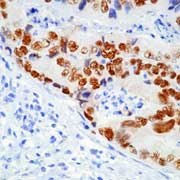生物来源
mouse
质量水平
抗体形式
purified antibody
抗体产品类型
primary antibodies
克隆
DO-7, monoclonal
表单
liquid
不包含
preservative
种属反应性
bovine, monkey, human
制造商/商品名称
Calbiochem®
储存条件
OK to freeze
avoid repeated freeze/thaw cycles
dilution
(Frozen Sections (1-2 µg/mL)
Immunoblotting (1-2 µg/mL)
Immunofluorescence (0.5 µg/mL)
Immunoprecipitation (2 µg/mg lysate)
Paraffin Sections (1-2 µg/mL))
同位素/亚型
IgG2b
运输
wet ice
储存温度
−20°C
靶向翻译后修饰
unmodified
基因信息
human ... TP53(7157)
一般描述
Purified mouse monoclonal antibody generated by immunizing BALB/c mice with the specified immunogen. Recognizes the ~53 kDa wild-type and mutant forms of p53.
Recognizes the ~53 kDa wild-type p53 and mutant p53 protein in SKBR-3 and MDA-231 cells and in colon carcinoma tissue.
This Anti-p53 (Ab-12) (Pantropic) Mouse mAb (DO-7) is validated for use in Frozen Sections, Immunoblotting, IF, IP, Paraffin Sections for the detection of p53 (Ab-12) (Pantropic).
免疫原
Epitope: within amino acids 37-45 of p53
recombinant, human p53 expressed in E. coli
应用


Frozen Sections (1-2 g/ml)
Immunoblotting (1-2 g/ml)
Immunofluorescence (0.5 g/ml)
Immunoprecipitation (2 g/mg lysate)
Paraffin Sections (1-2 g/ml)
包装
Please refer to vial label for lot-specific concentration.
分析说明
Positive Control
SKBR-3 or MDA-231 cells or colon carcinoma tissue
SKBR-3 or MDA-231 cells or colon carcinoma tissue
其他说明
Exhibits nuclear staining in tumor cells. Antibody should be titrated for optimal results in individual systems.
Greenblatt, M.S., et al. 1994. Cancer Res.54, 4855.
Lane, D.P. 1992. Nature358, 15.
Lane, D.P. 1992. Nature358, 15.
法律信息
CALBIOCHEM is a registered trademark of Merck KGaA, Darmstadt, Germany
免责声明
Toxicity: Standard Handling (A)
未找到合适的产品?
试试我们的产品选型工具.
储存分类代码
11 - Combustible Solids
WGK
WGK 1
闪点(°F)
Not applicable
闪点(°C)
Not applicable
Jinichi Mori et al.
Neoplasia (New York, N.Y.), 19(3), 185-195 (2017-02-06)
p53 activation by cellular stresses induces the transcription of hundreds of its target genes. To elucidate the entire picture of its downstream pathway, we screened a cDNA microarray dataset of adriamycin-treated HCT116 p53-/- or p53+/+ cells and identified EPSIN 3
Jinichi Mori et al.
Cancer science, 107(3), 298-306 (2016-01-13)
In response to various cellular stresses, p53 is activated and inhibits malignant transformation through the transcriptional regulation of its target genes. However, the full picture of the p53 downstream pathway still remains to be elucidated. Here we identified cystatin C
Franz Meitinger et al.
The Journal of cell biology, 214(2), 155-166 (2016-07-20)
In normal human cells, centrosome loss induced by centrinone-a specific centrosome duplication inhibitor-leads to irreversible, p53-dependent G1 arrest by an unknown mechanism. A genome-wide CRISPR/Cas9 screen for centrinone resistance identified genes encoding the p53-binding protein 53BP1, the deubiquitinase USP28, and
Varalee Yodsurang et al.
Oncotarget, 8(34), 55790-55803 (2017-09-17)
p53 mutation is a marker of poor prognosis in breast cancers. To identify downstream targets of p53, we screened two transcriptome datasets, including cDNA microarrays of MCF10A breast epithelial cells with wild-type p53 or p53-null background, and RNA sequence analysis
Yuki Funauchi et al.
Scientific reports, 5, 16497-16497 (2015-11-13)
Accumulation of iron in tissues increases the risk of cancer, but iron regulatory mechanisms in cancer tissues are largely unknown. Here, we report that p53 regulates iron metabolism through the transcriptional regulation of ISCU (iron-sulfur cluster assembly enzyme), which encodes
我们的科学家团队拥有各种研究领域经验,包括生命科学、材料科学、化学合成、色谱、分析及许多其他领域.
联系客户支持